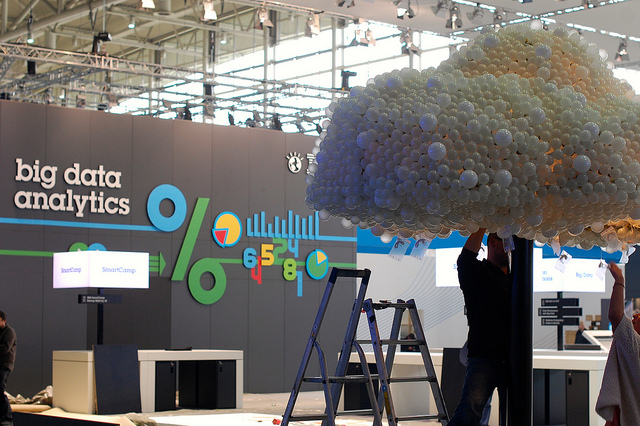
The EU General Data Protection Regulation (GDPR) has sparked much discussion about the “right to explanation” for the algorithm-supported decisions made about us in our everyday lives. While there’s an obvious need for transparency in the automated decisions that are increasingly being made in areas like policing, education, healthcare and recruitment, explaining how these complex algorithmic decision-making systems arrive at any particular decision is a technically challenging problem—to put it mildly.
In their article “Counterfactual Explanations without Opening the Black Box: Automated Decisions and the GDPR” which is forthcoming in the Harvard Journal of Law & Technology, Sandra Wachter, Brent Mittelstadt, and Chris Russell present the concept of “unconditional counterfactual explanations” as a novel type of explanation of automated decisions that could address many of these challenges. Counterfactual explanations describe the minimum conditions that would have led to an alternative decision (e.g. a bank loan being approved), without the need to describe the full logic of the algorithm.
Relying on counterfactual explanations as a means to help us act rather than merely to understand could help us gauge the scope and impact of automated decisions in our lives. They might also help bridge the gap between the interests of data subjects and data controllers, which might otherwise be a barrier to a legally binding right to explanation.
We caught up with the authors to explore the role of algorithms in our everyday lives, and how a “right to explanation” for decisions might be achievable in practice:
Ed: There’s a lot of discussion about algorithmic “black boxes” — where decisions are made about us, using data and algorithms about which we (and perhaps the operator) have no direct understanding. How prevalent are these systems?
Sandra: Basically, every decision that can be made by a human can now be made by an algorithm. Which can be a good thing. Algorithms (when we talk about artificial intelligence) are very good at spotting patterns and correlations that even experienced humans might miss, for example in predicting disease. They are also very cost efficient—they don’t get tired, and they don’t need holidays. This could help to cut costs, for example in healthcare.
Algorithms are also certainly more consistent than humans in making decisions. We have the famous example of judges varying the severity of their judgements depending on whether or not they’ve had lunch. That wouldn’t happen with an algorithm. That’s not to say algorithms are always going to make better decisions: but they do make more consistent ones. If the decision is bad, it’ll be distributed equally, but still be bad. Of course, in a certain way humans are also black boxes—we don’t understand what humans do either. But you can at least try to understand an algorithm: it can’t lie, for example.
Brent: In principle, any sector involving human decision-making could be prone to decision-making by algorithms. In practice, we already see algorithmic systems either making automated decisions or producing recommendations for human decision-makers in online search, advertising, shopping, medicine, criminal justice, etc. The information you consume online, the products you are recommended when shopping, the friends and contacts you are encouraged to engage with, even assessments of your likelihood to commit a crime in the immediate and long-term future—all of these tasks can currently be affected by algorithmic decision-making.
Ed: I can see that algorithmic decision-making could be faster and better than human decisions in many situations. Are there downsides?
Sandra: Simple algorithms that follow a basic decision tree (with parameters decided by people) can be easily understood. But we’re now also using much more complex systems like neural nets that act in a very unpredictable way, and that’s the problem. The system is also starting to become autonomous, rather than being under the full control of the operator. You will see the output, but not necessarily why it got there. This also happens with humans, of course: I could be told by a recruiter that my failure to land a job had nothing to do with my gender (even if it did); an algorithm, however, would not intentionally lie. But of course the algorithm might be biased against me if it’s trained on biased data—thereby reproducing the biases of our world.
We have seen that the COMPAS algorithm used by US judges to calculate the probability of re-offending when making sentencing and parole decisions is a major source of discrimination. Data provenance is massively important, and probably one of the reasons why we have biased decisions. We don’t necessarily know where the data comes from, and whether it’s accurate, complete, biased, etc. We need to have lots of standards in place to ensure that the data set is unbiased. Only then can the algorithm produce nondiscriminatory results.
A more fundamental problem with predictions is that you might never know what would have happened—as you’re just dealing with probabilities; with correlations in a population, rather than with causalities. Another problem is that algorithms might produce correct decisions, but not necessarily fair ones. We’ve been wrestling with the concept of fairness for centuries, without consensus. But lack of fairness is certainly something the system won’t correct itself—that’s something that society must correct.
Brent: The biases and inequalities that exist in the real world and in real people can easily be transferred to algorithmic systems. Humans training learning systems can inadvertently or purposefully embed biases into the model, for example through labelling content as ‘offensive’ or ‘inoffensive’ based on personal taste. Once learned, these biases can spread at scale, exacerbating existing inequalities. Eliminating these biases can be very difficult, hence we currently see much research done on the measurement of fairness or detection of discrimination in algorithmic systems.
These systems can also be very difficult—if not impossible—to understand, for experts as well as the general public. We might traditionally expect to be able to question the reasoning of a human decision-maker, even if imperfectly, but the rationale of many complex algorithmic systems can be highly inaccessible to people affected by their decisions. These potential risks aren’t necessarily reasons to forego algorithmic decision-making altogether; rather, they can be seen as potential effects to be mitigated through other means (e.g. a loan programme weighted towards historically disadvantaged communities), or at least to be weighed against the potential benefits when choosing whether or not to adopt a system.
Ed: So it sounds like many algorithmic decisions could be too complex to “explain” to someone, even if a right to explanation became law. But you propose “counterfactual explanations” as an alternative— i.e. explaining to the subject what would have to change (e.g. about a job application) for a different decision to be arrived at. How does this simplify things?
Brent: So rather than trying to explain the entire rationale of a highly complex decision-making process, counterfactuals allow us to provide simple statements about what would have needed to be different about an individual’s situation to get a different, preferred outcome. You basically work from the outcome: you say “I am here; what is the minimum I need to do to get there?” By providing simple statements that are generally meaningful, and that reveal a small bit of the rationale of a decision, the individual has grounds to change their situation or contest the decision, regardless of their technical expertise. Understanding even a bit of how a decision is made is better than being told “sorry, you wouldn’t understand”—at least in terms of fostering trust in the system.
Sandra: And the nice thing about counterfactuals is that they work with highly complex systems, like neural nets. They don’t explain why something happened, but they explain what happened. And three things people might want to know are:
(1) What happened: why did I not get the loan (or get refused parole, etc.)?
(2) Information so I can contest the decision if I think it’s inaccurate or unfair.
(3) Even if the decision was accurate and fair, tell me what I can do to improve my chances in the future.
Machine learning and neural nets make use of so much information that individuals have really no oversight of what they’re processing, so it’s much easier to give someone an explanation of the key variables that affected the decision. With the counterfactual idea of a “close possible world” you give an indication of the minimal changes required to get what you actually want.
Ed: So would a series of counterfactuals (e.g. “over 18” “no prior convictions” “no debt”) essentially define a space within which a certain decision is likely to be reached? This decision space could presumably be graphed quite easily, to help people understand what factors will likely be important in reaching a decision?
Brent: This would only work for highly simplistic, linear models, which are not normally the type that confound human capacities for understanding. The complex systems that we refer to as ‘black boxes’ are highly dimensional and involve a multitude of (probabilistic) dependencies between variables that can’t be graphed simply. It may be the case that if I were aged between 35-40 with an income of £30,000, I would not get a loan. But, I could be told that if I had an income of £35,000, I would have gotten the loan. I may then assume that an income over £35,000 guarantees me a loan in the future. But, it may turn out that I would be refused a loan with an income above £40,000 because of a change in tax bracket. Non-linear relationships of this type can make it misleading to graph decision spaces. For simple linear models, such a graph may be a very good idea, but not for black box systems; they could, in fact, be highly misleading.
Chris: As Brent says, we’re concerned with understanding complicated algorithms that don’t just use hard cut-offs based on binary features. To use your example, maybe a little bit of debt is acceptable, but it would increase your risk of default slightly, so the amount of money you need to earn would go up. Or maybe certain convictions committed in the past also only increase your risk of defaulting slightly, and can be compensated for with higher salary. It’s not at all obvious how you could graph these complicated interdependencies over many variables together. This is why we picked on counterfactuals as a way to give people a direct and easy to understand path to move from the decision they got now, to a more favourable one at a later date.
Ed: But could a counterfactual approach just end up kicking the can down the road, if we know “how” a particular decision was reached, but not “why” the algorithm was weighted in such a way to produce that decision?
Brent: It depends what we mean by “why”. If this is “why” in the sense of, why was the system designed this way, to consider this type of data for this task, then we should be asking these questions while these systems are designed and deployed. Counterfactuals address decisions that have already been made, but still can reveal uncomfortable knowledge about a system’s design and functionality. So it can certainly inform “why” questions.
Sandra: Just to echo Brent, we don’t want to imply that asking the “why” is unimportant—I think it’s very important, and interpretability as a field has to be pursued, particularly if we’re using algorithms in highly sensitive areas. Even if we have the “what”, the “why” question is still necessary to ensure the safety of those systems.
Chris: And anyone who’s talked to a three-year old knows there is an endless stream of “Why” questions that can be asked. But already, counterfactuals provide a major step forward in answering why, compared to previous approaches that were concerned with providing approximate descriptions of how algorithms make decisions—but not the “why” or the external facts leading to that decision. I think when judging the strength of an explanation, you also have to look at questions like “How easy is this to understand?” and “How does this help the person I’m explaining things to?” For me, counterfactuals are a more immediately useful explanation, than something which explains where the weights came from. Even if you did know, what could you do with that information?
Ed: I guess the question of algorithmic decision making in society involves a hugely complex intersection of industry, research, and policy making? Are we control of things?
Sandra: Artificial intelligence (and the technology supporting it) is an area where many sectors are now trying to work together, including in the crucial areas of fairness, transparency and accountability of algorithmic decision-making. I feel at the moment we see a very multi-stakeholder approach, and I hope that continues in the future. We can see for example that industry is very concerned with it—the Partnership in AI is addressing these topics and trying to come up with a set of industry guidelines, recognising the responsibilities inherent in producing these systems. There are also lots of data scientists (eg at the OII and Turing Institute) working on these questions. Policy-makers around the world (e.g. UK, EU, US, China) preparing their countries for the AI future, so it’s on everybody’s mind at the moment. It’s an extremely important topic.
Law and ethics obviously has an important role to play. The opacity, unpredictability of AI and its potentially discriminatory nature, requires that we think about the legal and ethical implications very early on. That starts with educating the coding community, and ensuring diversity. At the same time, it’s important to have an interdisciplinary approach. At the moment we’re focusing a bit too much on the STEM subjects; there’s a lot of funding going to those areas (which makes sense, obviously), but the social sciences are currently a bit neglected despite the major role they play in recognising things like discrimination and bias, which you might not recognise from just looking at code.
Brent: Yes—and we’ll need much greater interaction and collaboration between these sectors to stay ‘in control’ of things, so to speak. Policy always has a tendency to lag behind technological developments; the challenge here is to stay close enough to the curve to prevent major issues from arising. The potential for algorithms to transform society is massive, so ensuring a quicker and more reflexive relationship between these sectors than normal is absolutely critical.
Read the full article: Sandra Wachter, Brent Mittelstadt, Chris Russell (2018) Counterfactual Explanations without Opening the Black Box: Automated Decisions and the GDPR. Harvard Journal of Law & Technology (Forthcoming).
This work was supported by The Alan Turing Institute under the EPSRC grant EP/N510129/1.
Sandra Wachter, Brent Mittelstadt and Chris Russell were talking to blog editor David Sutcliffe.









